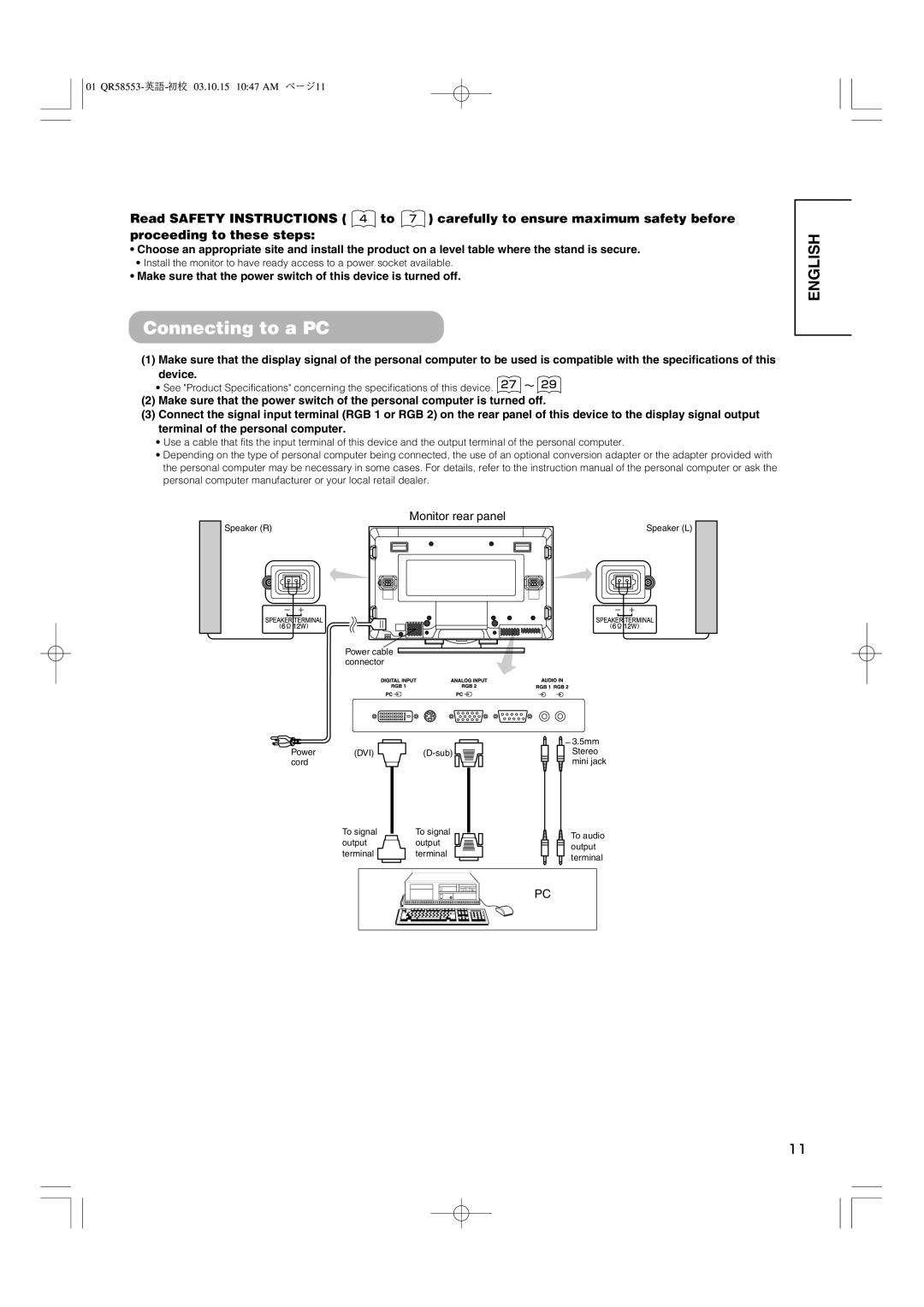32PD5000 42PD5000
Features
Contents
About the Symbols
Safety Instructions
Be careful in handling the battery of the remote control
Be cautious of the power cord connection
Be sure to keep safety ground connection
Safety Instructions
Set the sound volume at a suitable level
Precautions for the cable connection
Precaution during transportation
Do not physically impact the remote control
Main Unit
Component Names
Loading Batteries
Remote control
Handling the Remote Control
Securing to a wall or pillar
Installation Instructions
Installation
Anti-tumble measures
Monitor rear panel
Connecting to a PC
01 QR58553-英語-初校03.10.15 1047 AM ページ12
Indicating lamp
Turning Power On and Off
Operating Instructions
Audio Mute
Operating Instructions Volume Adjustment
Input Switching
When a button is pressed, the volume adjustment
Display area selection diagram RGB input
Size Switching
Input Signal Screen Display
Independent Operation of Multiple Monitors ID No
Using the Menu Screen On-screen display system
Automatic Adjustment of Screen Position and the Clock
Operating Instructions
Picture Menu
Movie Music Speech Favorite
Timer Menu
Off Timer Min 30Min 60Min 120Min 90Min On Timer
Audio Menu
Function Menu
Movie
Setup Menu
Menu Display Registration condition
Other Features
Language Menu
Automatic Store
Status Display Action
Other Features Signal Check
Power Save Mode
When the RGB1, RGB2 input is selected
About residual images
Image Retention of Plasma Display
Methods to Reduce the Occurrence of Image Retention
About screen defects
Check to see if the input signal matches the monitor
Troubleshooting
Symptoms That Seemingly Appear to be Failures
Check the way the signal cable is connected
01 QR58553-英語-初校03.10.15 1047 AM ページ25
Example
Troubleshooting Actions to Correct Abnormal Displays
Pin Input signal
Product Specifications
Signal Input
RGB terminal D-sub 15-pin connector
DVI terminal DVI-D
Product Specifications Signal Input
Recommended Signal List
With Digital RGB signal input RGB1 input
XGA
With Analog RGB signal input RGB2 input
Supplement
Optional Video Unit Function
Connecting to a Video Imaging Device
An example of connecting video imaging devices
With RGB component setup
AV1 AV2 AV3 RGB2 RGB1 AV4
Display size selection diagram
When you want to
Input signal Display screen Remarks
Press
Using a wide-screen monitor
Pictures Split
Operating Instructions Displaying Multi Picture
01 QR58553-英語-初校03.10.15 1047 AM ページ35
Red
Film Mode PAL Comb Filter
Operating Instructions Picture Menu
Black Enhancement Auto Color
Color Decoding
Color Management
Magenta
Cyan
AV2 1st step AV2 2nd step
System Color System
Video Input
RGB2 2nd step
Audio Input
Scart Output
RGB2 1st step
01 QR58553-英語-初校03.10.15 1047 AM ページ40
Not Used
Input connector pin specifications
Scart connector pin specifications
KHz MHz
Product Specifications Recommended Signal List
With R, G, B Video input AV2 and AV4 input
With component input AV1, AV2 and RGB2-component input
Optional Tuner Unit Function
Remote control provided for the optional tuner unit
Pressing this button. Each time pressed
You may recall the picture mode by
Picture mode is changed in following
Press this button to change input Surround On or Off Mode
Buttons for Teletext Mode
Monitor rear panel
Connecting Antenna
Precautions when connecting the antenna
Panoramic Full Cinema Zoom
TV AV1 AV2 AV3 RGB2 RGB1 AV4
Pictures Split 4 pictures 12 pictures
Activating the Split mode from the TV screen
Multi Picture button Multi Mode button Button
Name
Sound mode
Off-timer
Pictures
Split Strobe Panoramic
Picture Freezing
Freeze button
Split Strobe
Abcde
During TV mode
Auto Off
Operating Instructions Setup Menu
During Video signal input
Stereo sound broadcast
Other Functions
A2 / Nicam / Sound Multiplex
Bilingual / Dual sound broadcast
DVD Player Selection
Mode button Index button TV / Text button
SUB page buttons Reveal button Cancel button
Operating Instructions Other Functions
No picture or sound
Snowy picture poor sound
Multiple images sound O.K
Intermittent interference
01 QR58553-英語-初校03.10.15 1047 AM ページ56
Cushions
Application Model 42PD5000*,42PMA500*,42HDM70,CMP421
Speaker holder Speakers Speaker cable with core
Mounting screw
Attach the speaker brackets to the speaker systems
Attach the speaker systems to the monitor
Coussin
Modèle applicable 42PD5000*, 42PMA500*, 42HDM70, CMP421
Vis de montage
Pour bien immobiliser le dispositif
Fixer les haut-parleurs sur l’écran
Polster 2 Befestigungsschraube
Geeignetes Modell 42PD5000*,42PMA500*,42HDM70,CMP421
Lautsprecherhalterung Lautsprecherkabel mit Ader
Behandlung der Drahtenden
Bringen Sie die Lautsprecherbügel am Monitor an
Verwendung von Polstern
Bringen Sie die Lautsprecherverbindungskabel
Potenza massima d’ingresso
Attenzione
Come illustrato e tenerle per il ri
Fissare il sistema audio allo schermo
Uso degli ammortizzatori
Altavoces bidireccionales
Modelo Aplicable 42PD5000*,42PMA500*,42HDM70,CMP421
Apriete firmemente los cuatro tornillos
Abajo. Seguidamente, use los tornillos
Vibrationsdämpare
Högtalarhållare Högtalare Högtalarkabel med kärna
Monteringsskruvar
Anslutningskärmen
Montering av högtalarsystemet på skärmen
Om vibrationsdämparna
Puten 2 stk Monteringsskrue
Brukermodell 42PD5000*,42PMA500*,42HDM70,CMP421
Høytalerholder Høytalere Høytalerkabel med kjerne
Behandle trådendene
Monter høytalersystemene til monitoren
Skyv inn de to løsnede skruene inn
Feste høytalerholderene til skjermen
簡体中文
00 42型スピーカー統合-五校03.9.9 339 PM ページ16
繁體中文
00 42型スピーカー統合-五校03.9.9 339 PM ページ18
CMPAS14/CMPAS14S 取扱説明書
お知らせ

